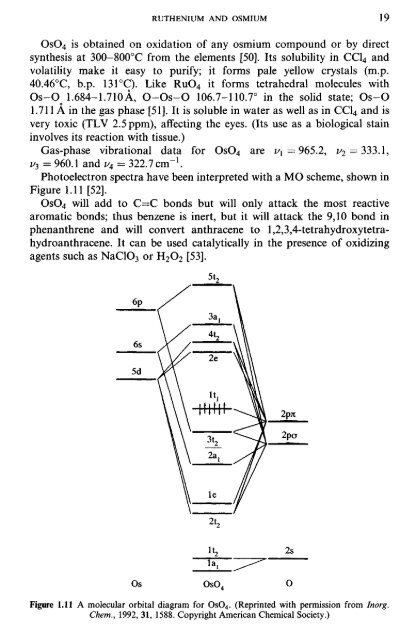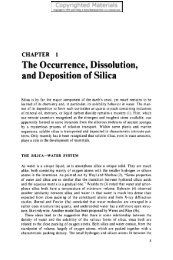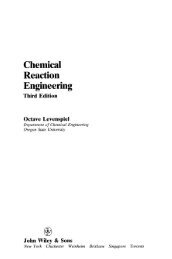Chemistry of Precious Metals - CNTQ
Chemistry of Precious Metals - CNTQ
Chemistry of Precious Metals - CNTQ
Create successful ePaper yourself
Turn your PDF publications into a flip-book with our unique Google optimized e-Paper software.
OsO4 is obtained on oxidation <strong>of</strong> any osmium compound or by direct<br />
synthesis at 300-80O 0 C from the elements [5O]. Its solubility in CCl4 and<br />
volatility make it easy to purify; it forms pale yellow crystals (m.p.<br />
40.46 0 C, b.p. 131 0 C). Like RuO4 it forms tetrahedral molecules with<br />
Os-O0 1.684-1.710A, O-Os-O 106.7-110.7° in the solid state; Os-O<br />
1.711 A in the gas phase [51]. It is soluble in water as well as in CCl4 and is<br />
very toxic (TLV 2.5ppm), affecting the eyes. (Its use as a biological stain<br />
involves its reaction with tissue.)<br />
Gas-phase vibrational data for OsO4 are ^1 — 965.2, V2- 333.1,<br />
1/3 = 960.1 and i/4 = 322.7cm" 1 .<br />
Photoelectron spectra have been interpreted with a MO scheme, shown in<br />
Figure 1.11 [52].<br />
OsO4 will add to C=C bonds but will only attack the most reactive<br />
aromatic bonds; thus benzene is inert, but it will attack the 9,10 bond in<br />
phenanthrene and will convert anthracene to 1,2,3,4-tetrahydroxytetrahydroanthracene.<br />
It can be used catalytically in the presence <strong>of</strong> oxidizing<br />
agents such as NaClO3 or H2O2 [53].<br />
Figure 1.11 A molecular orbital diagram for OsC^. (Reprinted with permission from Inorg.<br />
Chem., 1992, 31, 1588. Copyright American Chemical Society.)







